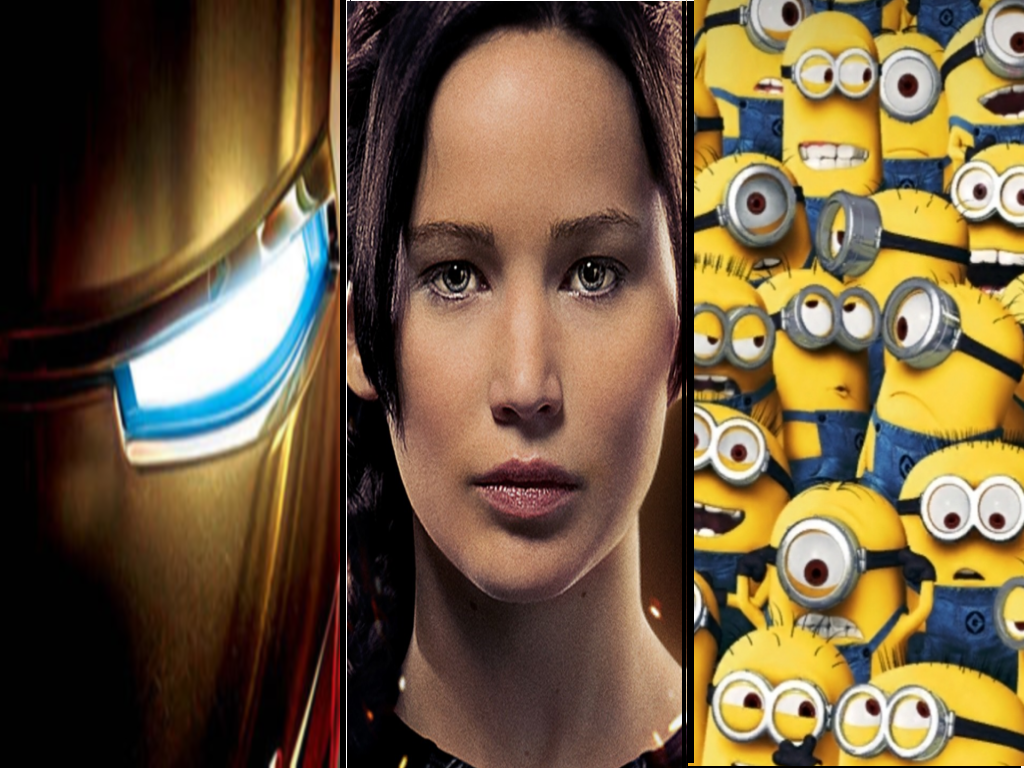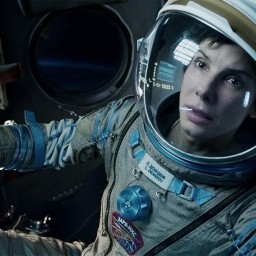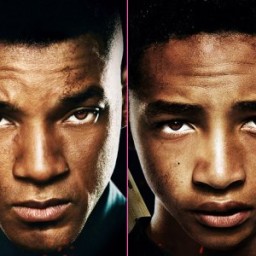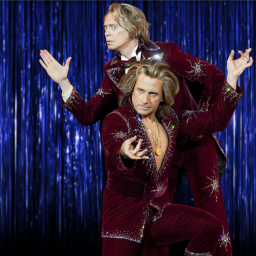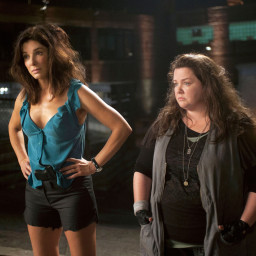In 2006, two Information Science professors at Oklahoma State University attempted to use “neural networks”—analytical techniques that are capable of modeling extremely complex non-linear functions—to predict box-office success. I am not even going to attempt and summarize the multi-layer perceptron (MLP) neural network used by the researchers in their model. What is of perhaps most interest are the variables used by the researchers in their study—MPAA rating, competition (month of release), star value, genre, special effects, sequel, and the number of screens a film was released on.
Analyzing data collected over a five-year span from 1998 to 2003, the researchers determined that the variables proving to be main predictors of box office success were the number of screens on which a film was released, high star power, and high technical effects. The researchers included explanations for the variables they used. Star value was determined by “averaging his/her recent history of movie-making prices” and were divided into three categories, A+/A (high) star value, B (medium) star value, and C (low) star value. The ratings of technical effects were also divided into three categories, high technical effects—such as science fiction or animated films—medium, and low technical effects.
Ignoring the no-brainer conclusion of the direct impact the number of screens a film is released on—the researchers themselves cited previous studies that demonstrated the “close correlations between a movie’s financial success and the number of screens it was shown on its initial launch”—the Oklahoma State study boils down a film’s likely box office success to its high star power and its high use of technical effects. According to this neural network model, competition (month of release), MPAA rating, and genre “do not have a significant contribution to a film’s success.”
A film that includes a star-studded cast and promises eye-catching visual effects—not to mention the increased use of 3-D technology, with saw its most recent adoption beginning after the OSU study’s publication date—sounds like an apt description of a Hollywood blockbuster. Curious to see whether the study’s conclusions were still applicable seven years later, I took a look at the 20 highest grossing films of 2013 to determine if they had shared variables for their success. The results are shown below.
(For the purpose of this quick box-office analysis, I considered the variables in relation to each other. For example, while Alfonso Cuaron’s “Gravity” may be set entirely in outer space and make use of impressive weightless camera tracking shots to convey the emptiness of space, this camera mastery—while visually impressive—fails in comparison to the gee-whiz over-the-top spectacle of the CGI-fueled “Iron Man 3.” On a similar note, while everyone might be familiar with Henry Cavill as Superman now, he was a relative unknown prior to the film’s release. After all, there was a reason that his name didn’t appear on the bulk of the film’s promotional materials. A supporting cast of Amy Adams, Russell Crowe, and Kevin Costner just isn’t enough to merit a “high”-ranking star value. And the “Sequel” category also connotes any sequel or reboot of a film, or an adaptation of a novel, comic book, or other previously published source material—pretty much any content that wouldn’t fit the definition of ‘original.’)
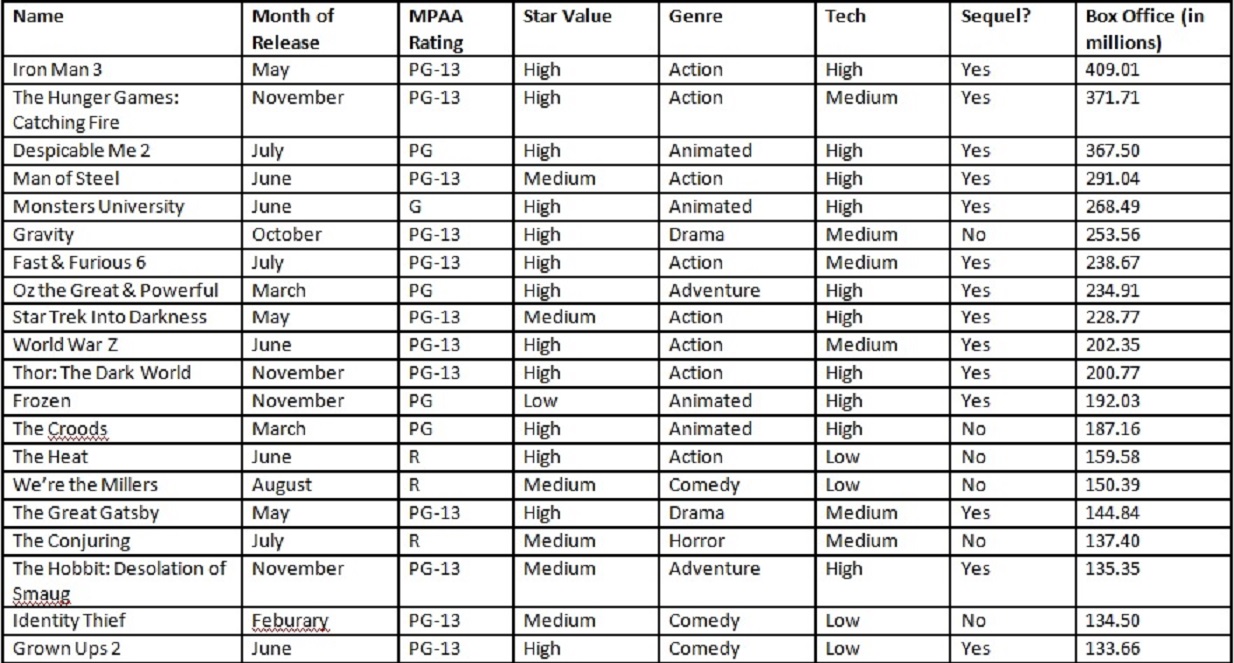 This breakdown of the top 20 highest-grossing films in 2013 (as of Christmas Eve) indicates that the month of release had little impact on a film’s box office success. In fact, the same number of films listed were released in what are typically identified as the ‘Highly Competitive’ months of June and November as were released in what is traditionally viewed as the ‘Low Competitive’ spring and fall months. Although more films were action films (8), this genre did not represent a significant impact on box office success. Indeed, even though a majority of these films were rated PG-13 (11), had a high-value star rating (13),or were sequels/adaptations (14), when a statistical analysis was performed to measure significance, only a film’s high technical/visual effects rating was identified to have a significant impact on a film’s box office—keeping in line, to a degree, with the results of the Oklahoma State University neural networks study from 2006.
This breakdown of the top 20 highest-grossing films in 2013 (as of Christmas Eve) indicates that the month of release had little impact on a film’s box office success. In fact, the same number of films listed were released in what are typically identified as the ‘Highly Competitive’ months of June and November as were released in what is traditionally viewed as the ‘Low Competitive’ spring and fall months. Although more films were action films (8), this genre did not represent a significant impact on box office success. Indeed, even though a majority of these films were rated PG-13 (11), had a high-value star rating (13),or were sequels/adaptations (14), when a statistical analysis was performed to measure significance, only a film’s high technical/visual effects rating was identified to have a significant impact on a film’s box office—keeping in line, to a degree, with the results of the Oklahoma State University neural networks study from 2006.
Of course, we are discussing a small sample size of 20 films, much less than the five years’ worth of data analyzed by the Oklahoma State researchers. If anything, this exercise is less effective in identifying trends as opposed to capturing a snapshot of moviegoers’ preferences in 2013. As such, the high number of PG-13 rated, star-studded, sequels that appear on the list shouldn’t be dismissed due to lack of statistical significance. (In fact, the statistical analysis did find that the box office impact of sequels did approach significance in 2013, the closest of any other categories.)
Recipe for Box Office Success = Recipe for Box Office Failure?
The idea that star-studded visual spectacles—with a tame enough MPAA rating to ensure a wide enough audience—translating into box office success seems obvious. At the same time, this description could apply to a number of 2013’s biggest box office disappointments.
Will Smith was the undisputed king of the summer blockbuster for nearly two decades, who averaged a $179 million box-office take with his last five films, including 2008’s lackluster “Seven Pounds.” Expectations were high for the effects-driven sci-fi “After Earth” which was a spectacular failure at the box office, finishing with a $60 million take that didn’t even cover half of the film’s $130 million production budget. Whether the poor showing was due to audiences unwilling to have Will Smith force his son Jaden—who received top billing—onto the world as a movie star, or simply due the continuing downward trajectory of director M. Night Shymalan’s career who, with the film’s dismal showing, should finally have the final nail shut on his once-promising directing career.
Tom Cruise and Matt Damon may both be certified Movie Stars™, but not even their screen presence could help prevent their smart and engaging “Oblivion” and “Elysium” from being box office duds. The possible problem for both films, perhaps, is simply relying on the original vision brought to the screen by relative newcomer filmmakers Joseph Kosinski and Neill Blomkamp, both helming their second features. (Yes, yes Kosinski adapted his graphic novel of the same name.) The poor showing of “Oblivion” is also the latest of Cruise’s continued struggles at the box-office. Since teaming up with Steven Spielberg in 2005’s “War of the Worlds” Cruise has yet to have a starring vehicle top the $100 million mark that isn’t a “Mission Impossible” sequel.
Perhaps the largest high-profile box-office flop in 2013 was “The Lone Ranger,” with Johnny Depp’s high-profile turn as Tonto unable to prevent this film from being a huge box-office disaster for Disney. The list of films that cost at least $200 million unadjusted dollars to produce is pretty short, but of that list “Ranger” joins “John Carter” and “Battleship” as the most expensive films unable to top $100 million at the box office. The film is a rare misstep for Depp and director Gore Verbinski, who had collaborated on the phenomenally successful “Pirates of the Caribbean” series as well as “Rango,” which netted the Oscar for Best Animated Feature. (Of course, it didn’t help casting a virtual unknown as Armie Hammer in the title role, denigrating the lead character as a second fiddle to Depp’s Tonto.)
On its recently released list of the top grossing actors of 2013, Forbes magazine has Steve Carrell ranked third, with the films he released bringing in just shy of $1 billion at the box office. Supposedly, this includes “The Incredible Burt Wonderstone” which–despite including the star power of both Carrell and formerly bankable Jim Carrey along with some visually impressive onstage illusion scenes—failed at the box office, bringing in only $22 million since its March release. (In other words, less than what Anchorman 2—an ensemble comedy which includes Carrell—made in its opening weekend.)
As mentioned earlier, the problem shared by most of these films is that they dared to offer an original story and vision to the big screen. “The Lone Ranger” was the obvious exception, but as a big-screen adaptation of characters that trace their toots to the Golden Era of radio, the chances for box office success was modest at best. The mid-90s box-office flops of “The Shadow” and “The Phantom”—similar characters that also trace their roots to the same era of radio drama—should’ve been an indication of the struggles that “Ranger” would’ve faced at the box office. Granted, episodes of “The Lone Ranger” were played repeatedly on the Disney Channel a generation ago, but those shows were watched by the parents of today’s 18-to-34 year olds, the most prized demographic by movie studios. As such, the kids that are the primary driver of American popular culture failed to line-up at the multiplex to see a 2.5-hour version of iconic characters that they might have heard of. “The Lone Ranger” relied strongly on nostalgia to succeed at the box office. However, a 50-year old with a painted face riding a horse wasn’t going to be found nostalgic by the targeted demographic, who instead would probably have more nostalgia for mid-90s Nickelodeon cartoons.
Also, another indication of a potentially weak box office? Horses. The inclusion of horses suggests a western, which will have lower visual effects than a science-fiction or animated film. There may have been some impressive action scenes in “The Lone Ranger” but they are unable to compare to the comic book heroics of Iron Man or Thor. There have been less than ten films identified as a “Western” to gross over $100 million, and of that list the two that also combined star power with visual effects not typically found in Western films—“Wild Wild West” and “Cowboys and Aliens”—both failed to make back their production costs. In short, a rule of thumb is that any steps towards box office success gained through a top-billed cast and visual effects are canceled out by the inclusion of horses.
Will 2014 see a repeat of “The Heat?”
Is there anything to glean from the box office successes—and misses—of 2013 to help make any box office predictions for 2014? In a story that accompanied the poor opening weekend performance of “Elysium”, Buzzfeed bemoaned the poor showing of original movies in 2013. Indeed, the numbers simply don’t lie: 70 percent of the 20 highest-grossing films in 2013 were sequels or big-screen adaptations of previous material. This makes sense. For a film to justify a $150-$160 million (or $200 million) production costs, it better be an adaptation of a known quantity, to bring in the comic book/novel/rebooted television show’s fan base and, hopefully, appeal to a wider audience.
The trend of relying on known quantities to generate blockbuster success is only slated to continue in 2014, which will see the latest entries in the Spider Man, X-Men, Transformers, Captain America, The Hobbit, and Hunger Games franchises, not to mention potential new franchises kicking off with a new take on Hercules, Frankenstein, Godzilla, and Guardians of the Galaxy comic-book adaptation. Big-screen versions of such novels as “Divergent”, “Gone Girl” and the Vampire Academy young-adult series are also slated for a 2014, along with movies based on a perpetually-favorite child’s toy (“The Lego Movie”) and a cult television show that raised its production costs through Kickstarter (“Veronica Mars.”)
Going out on a limb to suggest that the comic book movies slated for a 2014 release are going to be a big hit—as comic book movies typically are—isn’t much fun. And neither is suggesting that the upcoming “Godzilla” movie will trounce “Veronica Mars.” I’m more interested in trying to figure out which of next year’s big-budget sequels or adaptations —complete with a star-studded cast and impressive visual effects—are going to be a spectacular fail at the box office, similar to “The Lone Ranger.” (Unfortunately, the lack of horses in any of 2014’s slate of sequels and adaptations make that difficult to determine.)
Conversely, a more engaging question is what would 2014’s version of “The Heat” turn out to be? When “The Heat” turned out to be a mammoth hit this past year, I heard a number of discussions in which critics seemed amazed that a Paul Feig-helmed female-driven comedy could be such a success–and only two years after “Bridesmaids!” Besides the fact that “The Heat” was unconventional in having its two female leads deconstructing standard-issue buddy-cop and action movie tropes—and doing so in a completely hilarious manner—the Sandra Bullock-Melissa McCarthy comedy also inverted 2013’s recipe for box office success. As the R-rated original script relied on character interplay moreso than it did on visual effects, “The Heat” should not have been one of the year’s highest grossing films, yet it finished with a cumulative box office just shy of $160 million. (Fun fact: Sandra Bullock was one of two actresses that starred in two of 2013’s highest-grossing original live-action films, “The Heat” and “Gravity.” The other actress? Her “Heat” co-star Melissa McCarthy, who also struck it big at the box office with “Identity Thief.”)
So with the 2013 year in movies coming to a close the question of which original film in the upcoming year that somehow found unlikely box office success in 2014 is difficult to answer. If you were to make a guess at which film will be 2014’s version of “The Heat,” what would it be?

